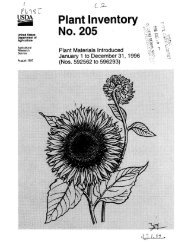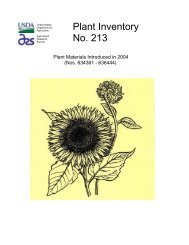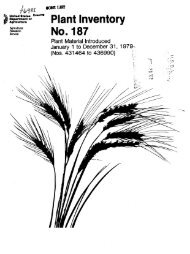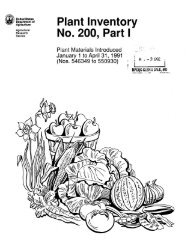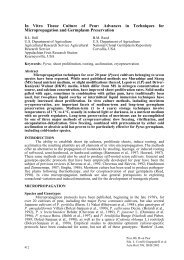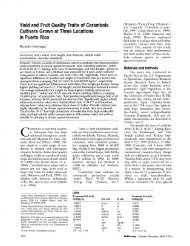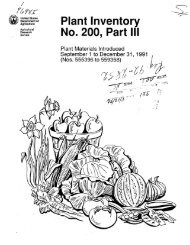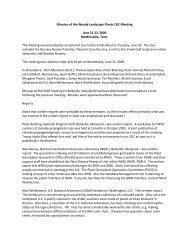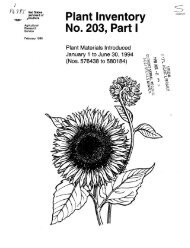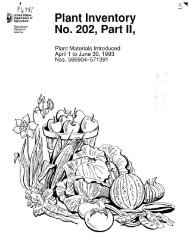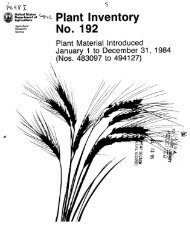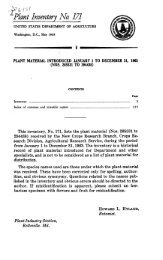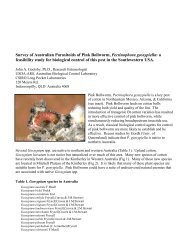Download - The Germplasm Resources Information Network
Download - The Germplasm Resources Information Network
Download - The Germplasm Resources Information Network
You also want an ePaper? Increase the reach of your titles
YUMPU automatically turns print PDFs into web optimized ePapers that Google loves.
Woody Landscape Plant Crop <strong>Germplasm</strong> Committee Annual Meeting<br />
teleconference<br />
hosted by USDA-ARS, Southern Horticultural Laboratory<br />
Monday, May 21, 2012, 1 p.m.<br />
Minutes<br />
Welcome and roll call:<br />
Kim Hummer, Ryan Contreras, Alan Meerow, Mark Widrlechner, Candice Gardner, Peter<br />
Bretting, Kevin Conrad, Kunso Kim, Jim Robbins, Joseph Postman, Richard Olsen, Margaret<br />
Pooler, Mark Bohning, Gary Kinard, Pam Allenstein, Alan Whittemore, Gail Wisler, and<br />
Richard Criley.<br />
Reports [please see appendix for written reports submitted to WLPCGC].<br />
Office of National Programs (ONP) – Peter Bretting<br />
National <strong>Germplasm</strong> <strong>Resources</strong> Laboratory (NGRL) - Mark Bohning and Gary Kinard<br />
National Clonal <strong>Germplasm</strong> Repository (NCGR) – Kim Hummer and Joseph Postman<br />
North Central Regional Plant Introduction Station (NCRPIS) - Candice Gardner in place of Jeff<br />
Carstens<br />
Woody Landscape Plant <strong>Germplasm</strong> Repository (WLPGR) and U.S. National Arboretum –<br />
Richard Olsen and Kevin Conrad<br />
Subtropical Horticulture Research Station (SHRS) - Alan Meerow<br />
North American Plant Collections Consortium (NAPCC) – Pam Allenstein<br />
Discussion:<br />
During the reports several topics came up including funding for FY 2012 <strong>Germplasm</strong> Evaluation<br />
Proposals. Peter Bretting indicated that awards were expected to be determined soon. Peter also<br />
answered questions about the Nagoya protocol as it relates to the Convention on Biological<br />
Diversity. Positive comments were made about the digitization of PI volumes and the<br />
international release of GRIN Global 1.0. <strong>The</strong>re was some discussion about publicizing the<br />
online release of the PI volumes through trade journal such as American Nurseryman or NM Pro.<br />
<strong>The</strong> committee discussed possible sites for next face to face meeting for the WLPCGC. A list of<br />
venues was generated and members voted by email after the meeting. [2012 WLPCGC meeting<br />
will be held in Portland, OR on Oct 1-4, 2013 in conjunction with IPPS western region<br />
conference].<br />
<strong>The</strong> retirement of Sandy Reed and resignation of Mark Krautmann and Jim Berry was discussed<br />
in relation to WLPCGC membership, which is a large committee. Names of potential new<br />
members were solicited with voting on new members by email after the conference call. [Stan<br />
Hokanson was added to represent woodies in USDA cold hardiness zones 3 and 4 since Harold<br />
Pellett retired]. Inactive membership was discussed and the committee agreed that members not<br />
present should be contacted about their desire to continue to serve. [All members contacted<br />
expressed a desire to continue on the committee and commitment to attend in 2013].
<strong>The</strong> germplasm evaluation proposal process was discussed. WLPCGC committee members<br />
ranked 11 proposals on short notice for FY 2012. It was determined that ideas to modify the call<br />
for proposals or the proposal ranking process would be discussed by email at a later time [Action<br />
Item].<br />
<strong>The</strong> minutes from 2010 were not distributed before the conference call and could not be<br />
approved [Action Item]. <strong>The</strong> updated Crop Status and Vulnerability Report from 2008 was<br />
discussed because it was not approved and posted to the USDA GRIN website. Richard Olsen<br />
has the working version from 2008 and volunteered to distribute this for review [Action Item].<br />
Nomination for a new WLPCGC Chair and Secretary were discussed. It was agreed that this<br />
process would be done by email [Action Item].<br />
Meeting adjourned.
2012 OFFICE OF NATIONAL PROGRAMS REPORT<br />
FOR THE U. S. NATIONAL PLANT GERMPLASM SYSTEM<br />
OFFICE OF NATIONAL PROGRAMS, NATIONAL PROGRAM 301: PLANT GENETIC RESOURCES,<br />
GENOMICS, AND GENETIC IMPROVEMENT<br />
(PETER BRETTING, DAVID MARSHALL, JACK OKAMURO, SALLY SCHNEIDER,<br />
ROY SCOTT, GAIL WISLER, DA KAY SIMMONS)<br />
1 Personnel changes:<br />
1.1 Farewell and best wishes to Mark Widrlechner who retired as Horticulturist and<br />
woody ornamental plant curator at Ames, IA; Ray Schnell, who retired as<br />
Research Geneticist and tropical fruit crop and sugar cane curator at Miami, FL;<br />
Steve Clement, who retired as Research Entomologist at Pullman; Chuck Simon,<br />
who retired as Grape Curator at Geneva; Ray Mock, who retired as a Plant<br />
Pathologist at NGRL, Beltsville, MD and Doug Cook who retired as IT specialist<br />
at Corvallis.<br />
1.2 Welcome to Thomas Chao, new grape, apple, and tart cherry curator at Geneva,<br />
NY; Noelle Barkley, new peanut curator at Griffin, GA; Osman Gutierrez, cacao<br />
Research Geneticist at Miami, FL; Hugo Cuevas, new sorghum Research<br />
Geneticist at Mayagüez, PR; and Pablo Jourdan, new director of the Ornamental<br />
Plant <strong>Germplasm</strong> Center, Columbus, OH. Roy Pittman, formerly peanut curator,<br />
assumed responsibility for the cowpea (Vigna) collection at Griffin.<br />
2 Site developments and changes:<br />
2.1 <strong>The</strong> USDA/ARS-NPGS partnered with Bioversity and the GCDT on a<br />
three-year, $1.4 million project to transform GRIN into GRIN-Global, a powerful<br />
but easy-to-use, Internet-based, plant genetic information management system<br />
that will link world's plant genebanks. NPGS personnel in Beltsville, MD and<br />
Ames, IA are leading the project. <strong>The</strong> nucleus of the system is ARS's existing<br />
GRIN, which already houses information about the more than 546,000 accessions<br />
of more than 14,000 plant species in the NPGS. Software upgrades will enable<br />
GRIN be used by genebanks of all sizes from many countries, making more<br />
information about more plants available to researchers. GRIN-Global v. 1.0 was<br />
released to the international community in December 2011. It will be<br />
implemented within the NPGS starting in late 2012.<br />
2.2 For many elite vegetatively-propagated genebank accessions,<br />
cryopreservation of shoot tips or dormant buds is often the most secure and costeffective<br />
means for long-term conservation. Cryopreservation protocols have<br />
traditionally been developed empirically, because the underlying physiological<br />
genetic process of regrowth following cryopreservation has been poorly<br />
understood. ARS researchers in Fort Collins, Colorado discovered some of the<br />
first physiological genetic details of how plant shoot tips recover from<br />
cryopreservation treatments. Shoot tips dehydrated with cryoprotectants, exposed<br />
to liquid nitrogen, and allowed to recover, expressed stress-related genes such as<br />
1
3 Budgets:<br />
heat shock proteins, antioxidants, dehydrins and other physiological<br />
“housekeeping genes.” This research is a key breakthrough in understanding the<br />
genetic and biological bases of variation among genotypes in their response to<br />
cryopreservation treatments, as well as their response to therapeutic treatments for<br />
recovering germplasm from cryogenic storage.<br />
2.3 Knowledge of geographical patterns of genetic variability is vital for efficient<br />
and effective management of genetic resources in situ and ex situ in genebanks.<br />
ARS researchers in College Station, Texas developed new DNA genetic markers<br />
for pecan (which also function with walnuts) which can reveal geographical<br />
patterns of genetic diversity and evidence of hybridization. To date, these new<br />
genetic tools have confirmed a lack of reproductive isolation for wind-pollinated<br />
pecans, and have contributed to the development of strategies for the safe<br />
introduction of new pecan species from Asia that might contribute genes for<br />
genetically improving the U. S. pecan crop, which has an annual farm gate value<br />
of hundreds of millions of dollars.<br />
2.4 High concentrations of oleic acid in the seeds are beneficial attributes for<br />
peanut, a globally important food legume and oilseed. ARS researchers in<br />
Griffin, Georgia, developed a real-time polymerase chain reaction genotyping<br />
assay for alleles of genes governing the high oleic acid trait in peanuts. This assay<br />
enables curators to identify particularly valuable accessions, and breeders to test<br />
seed or leaf tissue rather than via destructive chemical analyses of ground seeds.<br />
This rapid assay will help identify key genotypes linked to important agronomic<br />
traits, improve curatorial efficiency, and accelerate characterization of the<br />
progeny of peanut breeding crosses by eliminating undesirable seedlings.<br />
3.1 <strong>The</strong> current Administration’s research priorities for USDA include climate<br />
change, food safety, children’s nutrition/health, international food security, and<br />
bioenergy.<br />
3.2 <strong>The</strong> President’s FY 12 budget proposed substantial budget increases ($3.3<br />
million) for the NPGS. <strong>The</strong> FY 12 budget enacted by Congress did not include<br />
those increases. On the contrary, it reduced the USDA/ARS’s budget by about<br />
3.5%. Nine locations and one program will be closed, including the NPGS<br />
genebank at Palmer, AK. Closing the preceding locations will likely cost ARS an<br />
additional ca. $30 million or more for FY 12. <strong>The</strong> FY 12 budget reduction, on top<br />
of last FY’s reduction, will substantially affect the ability of some NPGS<br />
genebanks to address their objectives. <strong>The</strong> President’s FY 13 budget, announced<br />
on 13 Feb. 2012, proposes modest budget increases ($581,000) for the NPGS.<br />
<strong>The</strong> proposed FY 13 House budget does not include specific details for ARS’s<br />
budget, but it would reduce overall Federal government spending substantially.<br />
2
4 National Programs:<br />
ARS’s research portfolio is organized as a series of 18 national programs. Plant and<br />
microbial genetic resource management, genetic improvement, genomics, molecular and<br />
biological processes, biotechnology risk assessment, bioinformatics, and genome<br />
database management are incorporated into National Program 301 (see the WWW at:<br />
http://www.nps.ars.usda.gov/programs/programs.htm?NPNUMBER=301). During 2011,<br />
NP 301 completed its second five year cycle. Its accomplishments are described in the<br />
2006-2011 NP 301 Accomplishment Report available on the web at:<br />
http://www.ars.usda.gov/research/programs/programs.htm?np_code=301&docid=22191<br />
During late October 2011, NP 301 underwent an external review which in general found<br />
that the NPGS was performing high-quality research and service programs with<br />
significant impact (see Executive Summary of the panel review at the web site above).<br />
<strong>The</strong> external review was followed by teleconferences-webinars on 8 and 9 November<br />
2011 to inform scientists and customers-stakeholders of the review results. A<br />
customer/stakeholder workshop was held in Beltsville on November 15, 2011 to elicit<br />
input regarding future research needs and priorities. ARS leaders and researchers<br />
developed an Action Plan for the next five years of NP 301 research (see<br />
http://www.ars.usda.gov/SP2UserFiles/Program/301/NP%20301%20Action%20Plan%20<br />
2013-2017%20FINAL.pdf , and are holding ARS scientist teleconferences in 2012 as a<br />
prelude for developing individual Project Plans.<br />
5 National Plant <strong>Germplasm</strong> Coordination Committee (NPGCC):<br />
<strong>The</strong> NPGCC seeks to promote a stronger, more efficient, more widely-recognized and<br />
better utilized NPGS. Its goals are to facilitate the coordination of ARS, NIFA and SAES<br />
planning and assessment mechanisms for NPGS policy, organization, operations and<br />
support; promote awareness and understanding of the NPGS across ARS, NIFA, and<br />
SAES and more broadly to the scientific community; and serve as a vehicle for<br />
improving communications and discussions about issues impacting the NPGS with ARS,<br />
SAES, and NIFA. It will assess, develop and recommend to the SAES, ARS and NIFA<br />
strategies for improved coordination of NPGS activities; develop and recommend a<br />
process for improved communication of the value of the NPGS; initiate a strategic<br />
planning effort for the NPGS to better define and communicate the vision, mission and<br />
short- and long-term goals; and to evaluate the current funding models for the NPGS and<br />
report findings to the SAES directors, ARS and NIFA.<br />
<strong>The</strong> current members of the NPGCC are L. Sommers (Colorado State-SAES), Chair; E.<br />
Young (Executive Director, Southern Region); J. Colletti (Iowa State-SAES), G. Arkin<br />
(University of Georgia-SAES), T. Burr (Cornell University-SAES), A. M. Thro (NIFA),<br />
E. Kaleikau (NIFA), P. S. Benepal (NIFA), P. Bretting (ARS-Office of National<br />
Programs), D. Upchurch (ARS-Southern Plains Area), and G. Pederson (ARS-Griffin).<br />
NPGCC members made a joint presentation on the NPGS to the 2006 Experiment Station<br />
Section/State Agricultural Experiment Station/Agricultural Research Directors Workshop<br />
September 24-27, 2006. That presentation, plus testimonials from key Directors about the<br />
3
NPGS’s value, increased the NPGS’s visibility to this important group. In May 2007, the<br />
NPGCC recommended to the National Research Support Project Review Committee that<br />
it recommend restoring off-the-top funds designated for NRSP-5 (the Prosser, WA virusfree<br />
pome and stone fruit project) and NRSP-6 (the potato genebank project at Sturgeon<br />
Bay, WI) to their FY 06 levels to sustain these valuable efforts. Support for NRSP-6 has<br />
been maintained at the FY 06 level for FY 07, FY 08, and FY 09. <strong>The</strong> NPGCC met on<br />
June 5, 2008, in conjunction with the annual PGOC and biennial CGC Chairs meetings.<br />
It discussed the NPGS’s budget levels, funding for NRSP-5 and NRSP-6, the location of<br />
crop collections, and mechanisms for publicizing the NPGS. Similarly, the NPGCC met<br />
on 23-24 June 2009, 9 June 2010, and 16-17 June 2011 in Beltsville, MD to continue its<br />
work on these priority issues.<br />
6 International germplasm items:<br />
<strong>The</strong> FAO Treaty (IT) for Plant Genetic <strong>Resources</strong> for Food and Agriculture came into<br />
force on 29 June 2004, and beginning in 2007 its standard material transfer agreement<br />
(SMTA) for plant genetic resource exchange was adopted by Parties to the IT and the<br />
CGIAR Centers for distributing plant genetic resources. On 7 July 2008, the White<br />
House transmitted the IT to the Senate; ratification would require the advice and consent<br />
of a 2/3 majority of the Senate. <strong>The</strong> Senate Foreign Relations Committee (SFRC) held<br />
hearings on the IT on 10 November 2009. During their last Business Meeting of the<br />
111th Congress (30 November 2010), the SFRC voted the IT out of committee, for<br />
consideration by the full Senate. Unfortunately, the Senate adjourned on 22 December<br />
2010 without voting on the IT. <strong>The</strong> SFRC might schedule new hearings on the IT during<br />
2012, as a prelude to the full Senate for a vote for consent (or not) to IT ratification.<br />
Concurrently, the Convention on Biodiversity (CBD) adopted the voluntary, non-binding<br />
Bonn Guidelines on Access and Benefit-Sharing during the sixth Conference of Parties<br />
(COP-6) of the CBD at <strong>The</strong> Hague in April 2002. Starting in 2006, Parties to the CBD<br />
began negotiating what became the legally-binding Nagoya Protocol on Access to<br />
Genetic <strong>Resources</strong> and the Fair and Equitable Sharing of Benefits Arising from their<br />
Utilization. Adopted by the COP-10 on 29 Oct. 2010, the Nagoya Protocol is quite<br />
complicated, with many ambiguous components; its ramifications are currently under<br />
analysis (see http://ictsd.org/downloads/2010/11/abs-protocol.pdf for the text).<br />
<strong>The</strong> preceding developments at FAO and with the CBD will substantially affect<br />
international exchange of plant genetic resources, and the NPGS, whether or not the U. S.<br />
is ultimately a Party to either or both treaties. Precisely how these treaties will affect U.<br />
S. users of germplasm depends on the treaties’ implementations.<br />
4
Report to WLP Crop <strong>Germplasm</strong> Committee November 2011<br />
Kim Hummer, Research Leader Kim.Hummer@ars.usda.gov<br />
USDA ARS National Clonal <strong>Germplasm</strong> Repository, Corvallis, Oregon<br />
USDA ARS Arctic and Subarctic Plant Gene Bank, Palmer, Alaska<br />
Administrative Overview<br />
Presently the ARS administration is planning to close the Palmer, Alaska, station along with<br />
9 other locations throughout the country. <strong>The</strong> staff has been put on notice that this could happen.<br />
Many former employees have found new jobs and resigned. We have only 2 SY and 2 Technicians<br />
left at the facility. We are expecting to hear confirmation from Congress by Thanksgiving on the<br />
closure and additional cuts that the agency will experience.<br />
Genetic resources now at Palmer will need to be transferred back to Corvallis, Pullman, or<br />
will go to other collaborators such as the University of Alaska, Fairbanks, or the Alaska Plant<br />
Materials Center. We are waiting for guidance from National Program Staff and our Area<br />
Administration.<br />
Funding and Staffing<br />
NCGR-Corvallis<br />
This past year our IT specialist retired. We lost that position through attrition. Our FY 2011<br />
budget was $1.43 million. We are expecting that our FY 2012 will be about $100K less due to<br />
cuts and the closure of the Palmer, Alaska station (on which we were dependent). We have<br />
several retirement eligible employees in Corvallis and will probably lose an additional employee<br />
this year. We are hoping that we will be able to replace that position when the time comes. At the<br />
moment ARS is under a hiring freeze that will probably be released once the FY 2012 budget is<br />
approved (unless there are additional large cuts).<br />
Extramural Grants<br />
NCGR scientists have three SCRI grants during FY 2011:<br />
Ohelo $50,490<br />
Blueberry Genomic tools $63,325 + $15,200 matching<br />
RosBREED $27,500<br />
This was the final year for the Ohelo study and reports were given at ASHS and manuscripts are<br />
in preparation<br />
Thousands US $<br />
NCGR Funding<br />
1600<br />
1400<br />
1200<br />
1000<br />
800<br />
600<br />
400<br />
200<br />
0<br />
2001 2002 2003 2004 2005 2006 2007 2008 2009 2010 2011<br />
Non-Base 103 196 149 119 74 82.9 71 110 229 315 156<br />
IRC 28 163 203 200 162 162 162 187 198 192 192<br />
Net to Unit 749 831 1,016 1,219 1,274 1,274 1,265 1,264 1,235 1,235 1,264<br />
1
Corvallis<br />
Staffing<br />
Palmer<br />
Budget<br />
Palmer<br />
Staffing<br />
Thousands US $<br />
Federal FTE<br />
FTE<br />
1000<br />
900<br />
800<br />
700<br />
600<br />
500<br />
400<br />
300<br />
200<br />
100<br />
0<br />
ASPGRU Funding<br />
2004 2005 2006 2007 2008 2009 2010 2011<br />
Non-Base 0 0 0 0 0 0 0 0<br />
IRC 52.98 76.75 97.75 178.54 192.74 197.44 203.77 210.00<br />
Net to unit 895.93 869.11 840.43 754.93 744.55 727.71 729.95 734.61<br />
12<br />
11<br />
10<br />
9<br />
8<br />
7<br />
6<br />
5<br />
18<br />
17<br />
16<br />
15<br />
14<br />
13<br />
12<br />
11<br />
10<br />
2001 2002 2003 2004 2005 2006 2007 2008 2009 2010 2011<br />
Year<br />
2004 2005 2006 2007 2008 2009 2010 2011<br />
2
ASPGB Palmer funding is likely to be closed in FY2012.<br />
Staff<br />
NCGR Corvallis<br />
Permanent/Term Federal Staff<br />
Bruce Bartlett, Ag. Sci. Tech., Plant<br />
Distribution<br />
Nahla Bassil, Geneticist-Plants<br />
Missy Fix, Bio. Sci. Tech., Plants<br />
Kim Hummer, Research Leader/Curator<br />
April Nyberg, Bio. Sci. Tech., Genetics<br />
James Oliphant, Bio. Sci. Tech., Grhse. Mgr.<br />
Yvonne Pedersen, Program Assistant<br />
Joseph Postman, Plant Pathologist/Pear<br />
Curator<br />
Barbara Reed, Research Plant Physiologist<br />
Joe Snead, Ag. Sci. Tech., Field Manager<br />
Collections Management<br />
Dennis Vandeveer, Facilities Manager<br />
ASPGB Palmer<br />
Permanent/Term Federal Staff<br />
Kim Hummer, RL<br />
Dan Barney, Curator<br />
Dan Hall, Agri. Sci. Tech.<br />
Nancy Robertson, Research Plant Pathologist<br />
Todd Steinlage, Bio. Sci. Tech., Lab<br />
NCGR-Corvallis<br />
<strong>The</strong> 2009 Annual reports for NCGR Corvallis can be found at:<br />
http://www.ars.usda.gov/News/docs.htm?docid=15538 click on the year of interest.<br />
We had a record number of distributions in FY 2011: > 7,000 accessions sent out.<br />
3
NCGR latest Corvallis holdings can be found at<br />
http://www.ars-grin.gov/cgi-bin/npgs/html/stats/site.pl?COR<br />
Genus<br />
Accession<br />
s<br />
Taxa<br />
1<br />
Countrie<br />
s<br />
Actinidia 1 1 1<br />
Amelanchier 103 15 10<br />
Amelasorbus 1 1 1<br />
Aronia 7 1 2<br />
Asimina 48 8 2<br />
Castanea 79 5 7<br />
Ceanothus 40 11 2<br />
Chaenomeles 13 4 3<br />
Cornus 1 1 1<br />
Corylus<br />
Crataegomespil<br />
738 21 39<br />
us 3 1 1<br />
Crataegosorbus 1 1 1<br />
Crataegus 22 9 6<br />
Crataemespilus 1 1 1<br />
Cydonia 115 2 16<br />
Cynodon 5 1 1<br />
Duchesnea 5 1 3<br />
Empetrum 9 1 5<br />
Epigaea 1 1 1<br />
Fragaria 1748 42 39<br />
Fragotentilla 3 1 1<br />
Gaultheria 31 14 4<br />
Gaylussacia 20 6 2<br />
Hippophae 2 1 2<br />
Holodiscus 4 3 2<br />
Humulus 629 8 21<br />
Juglans 26 3 4<br />
Lonicera 76 8 6<br />
Lycium 8 4 5<br />
Malus 5 2 2<br />
Mentha 71 18 15<br />
Mespilus 56 3 10<br />
Peraphyllum 8 1 2<br />
Physocarpus 1 1 1<br />
Potentilla 5 3 3<br />
Psammisia 1 1 1<br />
Pseudocydonia 2 1 2<br />
Pyracomeles 1 1 1<br />
Pyronia 7 1 4<br />
Pyrus 2122 36 59<br />
Ribes 517 79 30<br />
Rubus 1969 171 55<br />
Sambucus 182 20 24<br />
Schisandra 11 3 3<br />
Sibbaldia 2 1 2<br />
Sorbaria 1 1 1<br />
Sorbaronia 5 4 3<br />
Sorbocotoneast<br />
er 3 2 3<br />
Sorbopyrus 11 2 7<br />
Sorbus 299 60 31<br />
Styrax 1 1 1<br />
Vaccinium 1579 67 33<br />
Zoysia 5 2 1<br />
=======<br />
=<br />
=======<br />
=<br />
Total 10604 6571 N.A.<br />
ASPGB Palmer <strong>The</strong> 2010 Annual report for ASPGB Palmer can be found at:<br />
http://www.ars.usda.gov/Main/docs.htm?docid=19218 click on “annual report”.<br />
Palmer shipped many rhubarb, currants, gooseberries, and mint to requestors during the year.<br />
4
Palmer Genera Accessions Taxa 1 Countries<br />
Bolboschoenus 4 1 1<br />
Calamagrostis 95 18 25<br />
Carex 125 49 8<br />
Chamerion 1 1 1<br />
Elaeagnus 24 2 2<br />
Eleocharis 2 1 1<br />
Empetrum 2 1 2<br />
Erigeron 1 1 1<br />
Eriophorum 6 4 4<br />
Galium 1 1 1<br />
Honckenya 8 1 2<br />
Juncus 42 11 3<br />
Kobresia 3 2 1<br />
Ligusticum 4 1 1<br />
Luzula 15 5 4<br />
Mentha 469 35 47<br />
Mertensia 3 1 2<br />
Micromeria 1 1 1<br />
Microseris 1 1 1<br />
Nephrophyllidium 1 1 1<br />
Oplopanax 12 2 2<br />
Paeonia 152 15 3<br />
Parnassia 3 2 2<br />
Phyllodoce 2 1 1<br />
Pycnanthemum 119 18 3<br />
Pyrola 1 1 1<br />
Rheum 83 8 13<br />
Rhododendron 1 1 1<br />
Ribes 750 83 37<br />
Schoenoplectus 10 3 2<br />
Scirpus 5 2 3<br />
Streptopus 1 1 1<br />
======== ========<br />
Total 1948 276 1 N.A.<br />
5
GRIN activity - Corvallis<br />
Genetic and Morphological Observation Counts loaded to GRIN. We made an effort this year to<br />
get our genetic obs (GOBS) and other observations (OBS) loaded to grin. Molecular information<br />
was obtained by Dr. Nahla Bassil and her staff.<br />
Location of<br />
Collection<br />
Primary, Backup<br />
Number of<br />
Accessions in<br />
GRIN<br />
Molecular<br />
Markers in<br />
GRIN<br />
Number of<br />
GOBS<br />
Number<br />
of OBS<br />
Genus<br />
Actinidia(Hardy) Corvllis, Davis 276 0 0 154<br />
Aronia Corvallis 7 0 0 0<br />
Fragaria Corvallis 1,746 20 2,640 17,104<br />
Lonicera Corvallis<br />
Palmer,<br />
75 0 0 0<br />
Ribes<br />
Corvallis 1,267 0 0 17,424<br />
Rubus Corvallis 1,968 38 2,692 7,233<br />
Sambucus Corvallis 181 0 0 0<br />
Vaccinium Corvallis 1,578 28 1,164 1,073<br />
Pyrus Corvallis 2,119 23 1,383 44,077<br />
Humulus Corvallis 628 8 384 82<br />
Corylus Corvallis 737 229 20,063 795<br />
Totals 10,582 346 28,326 87,942<br />
We are making an effort to load images of our accessions. Here are the counts of what we loaded<br />
this past year. Take a look at any taxon of choice and click the image box to see the images.<br />
Genus Number of images loaded in 2011<br />
Fragaria 2093<br />
Ribes 1203<br />
Rubus 1713<br />
Vaccinium 746<br />
Small fruit total 5755<br />
All COR genera total 11,007<br />
6
Explorations in 2011<br />
• Kim Hummer to Nova Scotia, July 2011 – collected 84 Vaccinium cuttings from the Dr. Sam<br />
Vander Kloet North American collection at the Agriculture and Agri-Food Canada<br />
Experiment Farm, Kentville, Nova Scotia.<br />
• Dan Barney to Alaska (Fairbanks) August 2011 – collected 50 Vaccinium, Rubus, Ribes,<br />
Empetrum accessions<br />
• Joseph Postman/John Preece to Albania September 2011- collected about 100 fruit and nut<br />
accessions for NCGR Corvallis and Davis.<br />
Publications<br />
Corvallis<br />
Bassil, Nahla, 2010. Microsatellite Markers: Valuable in Vaccinium L.<br />
http://nabrew.anr.msu.edu/uploads/files/9/Programbooklet.pdf NABREW Meeting Abstract.<br />
2010:36.<br />
Bassil, Nahla, Gilmore, Barbara, Mockler, Todd, Olmstead, James, Brown, Allan, Rowland,<br />
Lisa, 2010. SNP Mining in Blueberry Using Illumina GAII Sequencing. HortScience 45(8):<br />
S7-S8<br />
Bassil, Nahla, Gilmore, Barbara, Verde, Ignazio, Sosinski, Bryon, Arus, Pere, Fazio, Gennaro,<br />
Gasic, Ksenija, Clark, John, Byrne, David, Gradziel, Tom, Main, Dorrie, Morgante, Michele,<br />
Peace, Cameron, Iezzoni, Amy, 2010. A Coordinated Approach to Peach SNP Discovery in<br />
RosBREED IHC Lisbon Book of Abstracts Vol. 2:241.<br />
Bassil, Nahla, Martin, Ruth, 2010. Proceedings of the Second International Symposium on<br />
Molecular Markers in Horticulture Acta Horticulturae. Acta Horticulturae. 49(4):53-54.<br />
Bassil, Nahla, Postman, Joseph, and Sugar, David. 2011. Quince Genetic Relationships<br />
Determined Using Microsatellite Markers. Acta Hort. Pear Symposium. in press<br />
Bassil, Nahla, Volk, G.M. 2010. Standardized Phenotyping: Advantages to Horticulture,<br />
Introduction to the Workshop. HortScience. 45(9):1306.<br />
Bobev, S., Angelov, L.T., Govedarov, G.I., Postman, J.D. 2010. Quince (Cydonia oblonga)<br />
Emerges from the Ashes of Fire Blight. IHC Lisbon Book of Abstracts Vol. 1:58.<br />
Buck, E., Scalzo, J., Hurst, R., McGhie, T., Allan, A., Rowland, L.J., Bassil, N.V., Hancock, J.<br />
2010. Progress in Blueberry Research in New Zealand.<br />
http://nabrew.anr.msu.edu/uploads/files/9/Programbooklet.pdf NABREW Meeting Abstract.<br />
2010:37.<br />
Castillo, N.R., Reed, B.M., J. Graham, F. Fernández-Fernández and Basil, N.V.. 2010.<br />
Microsatellite markers for raspberries and blackberries. Journal American Society of<br />
Horticultural Science 135: 271 – 278.<br />
7
Castillo, N.R., N.V. Basil, S. Wada and B.M. Reed. 2010. Genetic stability of cryopreserved<br />
shoot tips of Rubus germplasm. In Vitro Cellular and Developmental Biology – Plant.<br />
46:246-256.<br />
Dossett, Michael, Bassil, Nahla, Finn, Chad. 2010. Detection of Sequence Polymorphism in<br />
Rubus occidentalis L. Monomorphic Microsatellite Markers by High Resolution Melting.<br />
IHC Lisbon Book of Abstracts Vol. 2:33.<br />
Finn C. Bassil N, Hancock, J. Davis T. Denoyes-Rothan, B. Rees, J., Sargent D. Stewart, P.<br />
Luby J. Peace, C. Sebolt, A., Weebade, C. Van de Weg, E, Iezzoni, A. 2010. Genetic<br />
Improvement of Strawberry Fruit Quality with the RosBREED Approach. IHC Lisbon Book<br />
of Abstracts Vol. 2:29.<br />
Gasic, K, Brown S, Byrne, D., Clark J., Davis T., Evans, K. Finn C., Gradziel, T. Hancock, J.<br />
Luby, J. Oraguzie, N. Bassil, N., Fazio, G., Main, D., McFerson, J. Peace, C. van de Weg, E.,<br />
Weebade C, Yue, C. Iezzoni, A., 2010. Marker-Assisted Breeding Enabled by RosBREED.<br />
IHC Lisbon Book of Abstracts Vol. 2:271.<br />
Hancock, J., Finn, C.E., Wheeler, E., Graham, J., Mccallum, S., Olmstead, J., Bassil, N.V.,<br />
Rowland, L.J. 2010. Chilling Requirement, Cold Hardiness and Fruiting Characteristics of a<br />
“Draper” X “Jewel” Population Planted at Multiple Sites.<br />
http://nabrew.anr.msu.edu/uploads/files/9/Programbooklet.pdf NABREW Meeting Abstract.<br />
2010: p.55.<br />
Henning, J., Townsend, M.S., Gent, D.H., Bassil, N.V. 2010. Genetic Effects and Epistasis<br />
among QTLs Conferring Powdery Mildew Susceptibility in (Humulus lupulus L) IHC Lisbon<br />
Book of Abstracts Vol. 2:274.<br />
Hoefer, M., Reed, B.M. 2010. Conservation Strategy of Strawberry Genetic <strong>Resources</strong> in<br />
Germany. Abstract of International Horticultural Congress. 2:524.<br />
Hummer, K. E. 2010. Rubus Pharmacology: Antiquity to the Present. HortScience. 45:1587-<br />
1591.<br />
Hummer, K.E. 2010. Bringing Science to the People. Chronica Horticulturae 50(4):3.<br />
Hummer, K.E. 2010. Promoting Collaboration Between ISHS, the Global Crop Diversity Trust,<br />
and Bioversity International. IHC 2010. Book of Abstracts. Vol. 1: 301.<br />
Hummer, K.E., Postman, J.D., Iketani, H., Imanishi, H. 2010. Japan – United States<br />
Expedition to Hokkaido and Northern Honshu to Collect Fruit and Nut Genetic <strong>Resources</strong>.<br />
International Horticultural Congress. Book of Abstracts Vol. 2:524.<br />
Hummer, Kim, Bassil, Nahla, Njuguna, Wabui, 2011. Fragaria. Book Chapter. 6(Wild Crop<br />
Relatives):17-44. Springer. Heidelberg, Germany.<br />
8
Iketani, H., Hummer, K.E., Postman, J.D., Imanishi, H., Mase, N. 2010. Collaborative<br />
Exploration between NIAS Genebank and USDA ARS for the Collection of Genetic<br />
<strong>Resources</strong> of Fruit and Nut Species in Hokkaido and the Northern Tohoku Region. Journal<br />
of Japanese Botany. 26:13-26.<br />
Janick, J., Hummer, K.E. 2010. Healing, Health, and Horticulture: Introduction to the<br />
Workshop. HortScience. 45(11): 1584-1586.<br />
Jenderek, M. M., Ambruzs, B.D., Postman, J.D., Ellis, D.D. 2010. Dormant Bud Preservation<br />
for <strong>Germplasm</strong> Conservation. Meeting Abstract. 12th International Association for Plant<br />
Biotechnology, St. Louis, Missouri, June 6-11, 2010. p.53.<br />
Karp, D., and Postman, J.D. and Hummer, K.E.. 2010. Commercial Cultivation of Tejocote<br />
(Crataegus mexicana) in California. IHC Lisbon Book of Abstracts Vol. 1:60. Abst.<br />
Kovalchuk, I., T. Turdiev, S. Kushnarenko, I. Rakhimbaev and B.M. Reed. 2010.<br />
Cryopreservation of raspberry cultivars: Testing techniques for long-term storage of<br />
Kazakhstan’s plant germplasm. <strong>The</strong> Asian and Australasian Journal of Plant Science and<br />
Biotechnology p. 1-4.<br />
Kushnarenko, S., E. Salnikov, M. Nurtazin, Z. Mukhitdinova, I. Rakhimbaev and Reed, B.M.<br />
2010. Characterization and Cryopreservation of Malus sieversii Seeds. <strong>The</strong> Asian and<br />
Australasian Journal of Plant Science and Biotechnology pp 5-9.<br />
Kushnarenko, S., I. Kovalchuk, Z. Mukhitdinova, E. Rakhimova and Reed, B.M. 2010. Cold<br />
acclimation and cryopreservation treatments increase the cell size of apple meristem cells<br />
during cryopreservation. <strong>The</strong> Asian and Australasian Journal of Plant Science and<br />
Biotechnology p. 10-20.<br />
McCallum, S., Woodhead, M., Jorgensen, L., Gordon, S., Brennan, R., Graham, J., Hackett, C.,<br />
Rowland, L.J., Hancock, J., Olmstead, J., Bassil, N.V. 2010. Developing Tools for Long-<br />
Term Breeding of Blueberry <strong>Germplasm</strong> for UK Production. NABREW Conference July<br />
25-28, 2010, in Kalamazoo, MI. Meeting Abstract. p.37.<br />
Mota, J.A., Hummer, K.E., Williams, R. 2010. Berry Trials in the Azores. IHC Lisbon Book<br />
of Abstracts Vol. 2:579.<br />
Nathewet, P. Hummer K.E.,Y. Iwatsubo,K. Sone, and T. Yanagi. 2010. Karyotype analysis in<br />
octoploid and decaploid wild strawberries, Fragaria (Rosaceae). Cytologia. 75(3):277-288.<br />
Nathewet, P., Hummer, K.E.,Y. Iwatsubo,K. Sone, and T. Yanagi. 2010 Karyotype analysis in<br />
wild diploid tetraploid and hexaploid wild strawberries, Fragaria (Rosaceae). Cytologia<br />
74:355-364.<br />
Njuguna, W., Hummer, K.E., Richards, C., Davis, T.M., Bassil, N.V. 2009. Genetic Diversity<br />
of Diploid Japanese Strawberry Species Based on Microsatellite Markers. Acta Horticulturae<br />
9
842:581-584.<br />
Njuguna, Wambui, Bassil, Nahla, 2010. DNA Barcoding: Unsuccessful for Species<br />
Identification in Fragaria L. IHC 2010 Book of Abstracts. Vol. 2. p. 557<br />
Postman, J. D. and Hummer, K.E. 2010. Intergeneric Pome Fruit Hybrids in Pyrinae, A<br />
Subtribe of Pyreae in Family Rosaceae . IHC Lisbon Book of Abstracts Vol. 1:58. Abst.<br />
Postman, J.D., Volk, G.M., Aldwinckle, H. 2010. Standardized Plant Disease Evaluations will<br />
Enhance Resistance Gene Discovery. HortScience. 45:1317-1320.<br />
Reed, B.M. 2010. Techniques for Short and Long-Term Preservation of Plant Tissues and<br />
Organs. In Vitro Cellular and Developmental Biology – Plant. 46:S284.<br />
Reed, B.M., Uchendu, E., Muminova, M., Traber, M. 2010. Improving Shoot Tip<br />
Cryopreservation with Antioxidant and Antistress Compounds. In Vitro Cellular and<br />
Developmental Biology – Plant. 46:S280.<br />
Rowland, L.J., Alkharouf, N., Bassil, N.V., Beers, L., Bell, D.J., Buck, E., Drummond, F.A.,<br />
Finn, C.E., Graham, J., Handock, J., Mccallum, S., Olmstead, J. 2010. Generating Genomic<br />
Tools for Blueberry Improvement [abstract].<br />
http://nabrew.anr.msu.edu/uploads/files/9/Programbooklet.pdf NABREW Meeting Abstract.<br />
2010:36.<br />
Rowland, L.J., Alkharouf, N., Bassil, N.V., Beers, L., Bell, D.J., Buck, E., Drummond, F.A.,<br />
Finn, C.E., Graham, J., Handock, J., Mccallum, S., Olmstead, J. 2010. Generating Genomic<br />
Tools for Blueberry Improvement – an Update of our Progress. HortScience. 2010:45(8)<br />
S197.<br />
Uchendu, E.E., M. Muminova, S. Gupta and B.M. Reed. 2010. Antioxidant and anti-stress<br />
compounds improve regrowth of cryopreserved in vitro grown Rubus shoot tips. In Vitro<br />
Cellular and Developmental Biology – Plant. 46:386-393.<br />
Volk, G.M., Peace, C., Gasic, K., Bassil, N.V., Main, D. 2010. Standardized Phenotyping: A<br />
Coordinated Effort for Malus, Pyrus, Prunus and Fragaria. Meeting Abstract. 5th<br />
International Rosaceae Genomics Conference, November 14-17, 2010. South Africa. p. 53.<br />
Wada, S. and B.M. Reed. 2010. Seed coat morphology differentiates blackberry cultivars.<br />
Journal of the American Pomological Society 64(3):151-160.<br />
Wada, S., DeNoma, J. S., Niedz, R.P., Evens, T.J., Reed, B.M. 2010. Improved Mineral<br />
Nutrition for Pear Shoot Cultures. In Vitro Cellular and Developmental Biology – Plants.<br />
46:S282.<br />
Zee, F., Hamasaki, S. Nakamoto, T., Keith, L., Hummer, K., Reed, B., and Kawabata, A. 2010.<br />
Producing Potted Ornamental ‘Ōhelo. Ornamentals and Flowers. Apr. 2010. OF-50. College<br />
of Tropical Agriculture and Human <strong>Resources</strong>. University of Hawaii at Manoa. p.8 .<br />
10
Publications – Palmer for FY 2010<br />
Furman, Bonnie J. Robertson, Nancy L. and. Hummer Kim E. 2010. New Clonal Emphasis for<br />
the Arctic and Sub-Arctic Plant Genetic <strong>Resources</strong> Unit in Palmer, AK. HortScience. August<br />
Abst. 55.<br />
Furman, Bonnie J. Robertson, Nancy L. and. Hummer Kim E. 2010. <strong>The</strong> USDA ARS Rhubarb<br />
Collection. HortScience August. Abst. 56.<br />
Robertson, N. L., and Furman, B. J. Assessment of the Arctic and Subarctic Plant Gene Bank’s<br />
Mentha sp. <strong>Germplasm</strong> Collection for Selected Viruses. (In Review)<br />
Robertson, N. L. , Smeenk, J., and Anderson, J. 2010. Molecular Characterization of Potato leafroll<br />
virus, Potato virus A, and Potato virus X Isolates from Potatoes in Alaskan Cities and Villages.<br />
Plant Health Progress. doi. 10.1094/PHP-2011-0209-01-BR, online<br />
http://www.plantmanagementnetwork.org/php/<br />
Robertson, N. L. and Brown, K. L. 2010. First Report of Bean yellow mosaic virus in Alaska from<br />
clover (Trifolium spp.) Plant Disease 94(3): 372.<br />
Robertson, N. L., and Furman, B. J. 2010. Serological detection and molecular analysis of Tobacco<br />
ringsot virus.<br />
Action Item requested of the Committee<br />
We request support for two potential plant collecting expeditions for FY 2012, should resources<br />
be available from the PEO. If the Crop <strong>Germplasm</strong> Committee supports these collecting trips a<br />
letter should be sent by the chair to Karen Williams of the USDA ARS Plant Exchange Office.<br />
Exploration proposals will be supplied to the committee in due course.<br />
• Kim Hummer – Return to Nova Scotia in FY 2012 to obtain subtropical Vaccinium at<br />
Acadia, University, Wolfville, NS, and repropagations of unsuccessful propagations from the<br />
North American Vaccinium collection.<br />
• Dan Barney / Stephanie Green to Siberia to collect small fruit / grains. <strong>The</strong> grant was<br />
submitted this year – but approvals and funds were not completed in a timely manner. This<br />
proposal will be resubmitted for a subsequent year, depending on budget.<br />
11
Report to the Woody Landscape Plant Crop <strong>Germplasm</strong> Committee<br />
from the North Central Regional Plant Introduction Station (NCRPIS), Ames, Iowa<br />
Jeffrey D. Carstens, Horticulture Technician<br />
US Department of Agriculture - Agricultural Research Service<br />
Email: Jeffrey.Carstens@ars.usda.gov<br />
09 May 2012<br />
Since our last meeting in May 2010, NCRPIS has accessioned 215 new woody landscape plants and<br />
herbaceous ornamentals. Over half of the new acquisitions are Fraxinus, which were obtained during two<br />
expeditions in 2010 (an early September trip taken by Jeff Carstens and Matt O’Hearn focused on F.<br />
quadrangulata in and near the Ozarks and a late September trip taken by Jeff Carstens and Egon<br />
Humenberger focused on F. pennsylvanica, F. nigra, and F. americana in Wisconsin) and one expedition<br />
in 2011 (taken by Jeff Carstens, Andrew Schmitz, and Michael Dosmann in New York and Pennsylvania).<br />
Other significant acquisitions included samples of wild populations of Aronia (donated by Mark Brand and<br />
Bryan Connolly, Univ. of Connecticut) and Cornus alternifolia (collected by various cooperators<br />
throughout the U.S.).<br />
Maintenance efforts in 2010 and 2011 continued towards the regeneration of shrubs in cages. This was<br />
the fifth year for one cage field of woody shrubs, including 31 accessions, focusing on Cornus, Rhus,<br />
Ligustrum, Staphylea, and Aronia. This was the third year for one cage field of Aronia, including 39<br />
accessions. In 2010, we harvested 48 woody ornamental accessions (36 cage increases and 12<br />
isolations). In 2011, a total of 57 woody ornamental accessions were harvested. As a result of<br />
successful regenerations in 2010 and 2011 along with efforts to obtain large, original seed samples, 159<br />
accessions have been made available.<br />
In 2010 and 2011, a total of 37 accessions of woody plants were established from seeds, focused on<br />
Cornus and Caragana regenerations and miscellaneous taxa for the NC7 Regional Woody Ornamental<br />
Trials. It was interesting to note a 1984 seed lot of Fraxinus quadrangulata had a germination rate of<br />
20%.<br />
We anticipate harvesting from about 73 tree and shrub accessions during the 2012 growing season.<br />
Nearly half of these accessions are Aronia. Future germination efforts geared towards woody ornamental<br />
regenerations are being drastically reduced in order to finish out current woody cage fields. Now that a<br />
new field for Salix clones has been successfully established, efforts will be directed in a similar fashion for<br />
Ulmus. Efforts will also be directed towards obtaining observation data and taxonomic verification of<br />
Aronia.<br />
In 2010, passport data of newly available Ames numbers was proofed for PI-number assignment. This<br />
resulted in the assignment of 28 new PI numbers for woody-ornamental accessions. Currently, 46% of<br />
ornamental accessions are available for distribution and 44% are backed-up at the National Center for<br />
Genetic <strong>Resources</strong> Preservation (NCGRP) in Fort Collins. Another year of testing of dormant vegetative<br />
buds of Salix occurred in winter of 2010/2011 in collaboration with Maria Jenderek at NCGRP.<br />
<strong>The</strong> field books documenting our long-term plantings were updated in 2010 to reflect newly planted<br />
accessions. Liner inventories were updated in the GRIN database by using the Pocket Actions program.<br />
Inventories will be updated in summer 2012 to reflect the large number of accessions being removed as a<br />
result of sufficient seed harvests.<br />
In 2010 and 2011, a total of 248 and 405 accessions, respectively, were distributed.<br />
In 2010 and 2011, 136 and 192 ornamental images, respectively, were loaded to GRIN, by using the<br />
mass-loading system for images developed by Pete Cyr. For 2010, 5 tree and shrub accessions were<br />
distributed for evaluation in the NC-7 Ornamental Trials, resulting in the shipment of 161 plants to 15 sites<br />
for long-term evaluation and an additional 42 plants provided to 8 public gardens. For 2011, 5 tree and<br />
shrub accessions were distributed for evaluation in the NC-7 Ornamental Trials, resulting in the shipment<br />
of 237 plants to 17 sites for long-term evaluation and an additional 80 plants provided to 6 public gardens.
In October 2011, Mark Widrlechner shared information about Fraxinus seed collection efforts through a<br />
formal presentation and many informal discussions with other ash researchers. As part of the process to<br />
assemble representative Fraxinus collections, the ARS Plant Exchange Office (PEO) supported collection<br />
trips to the Ozarks and Wisconsin in 2010 and also New York and Pennsylvania in 2011. A formal<br />
exploration proposal has been submitted for collecting blue ash and other woody landscape plants in<br />
Illinois and Indiana for 2012. <strong>The</strong> NPGS Ash Conservation website is operating and typically updated<br />
during the winter months once newly received collections have been stored.<br />
An update is provided on the development status of the GRIN-Global System, a major project coordinated<br />
from Ames to create a flexible, modern, modular genebank database system to serve as a new standard<br />
for the world’s genebanks. <strong>The</strong> effort includes both the National Plant <strong>Germplasm</strong> System (NPGS) and<br />
Bioversity International and is supported by USDA-ARS and the Global Crop Diversity Trust. Both the<br />
internal workings of GRIN and its public interface are being transformed. <strong>The</strong> unique system utilizes a<br />
three-tiered design where the server (or middle tier), database engine, and interfaces are independent of<br />
each other. Communication is achieved by passing html language between the client interface and the<br />
server, and xlm language between the search tool or curator tool and the server. It can be used on<br />
stand-alone PCs or on networked systems. <strong>The</strong> system design reflects the need for ultimate flexibility to<br />
enable any genebank to adopt the system and customize it to fit their operations, workflows, and local<br />
language, and also for ease of use. It supports four database engines, MS SQL Server, MySQL,<br />
PostgreSQL and Oracle. Version 1.0 is being released at the end of October and international personnel<br />
responsible for deploying and administering the system, as well as curatorial personnel, are being trained.<br />
Implementation in the U.S. to replace the legacy GRIN system is anticipated in late 2012; much work<br />
remains to address the workflows and peripheral programming needs of the 26 U.S. NPGS sites, and to<br />
migrate the content of GRIN Classic.<br />
For more information on GRIN-Global development, and to test the public interface, please<br />
see http://www.grin-global.org/index.php/Main_Page . Pete Cyr, the NCRPIS’s Applications Development<br />
Specialist, serves as the project leader. Many of our staff members, along with colleagues from DBMU in<br />
Beltsville, other NPGS sites, international genebanks, and contract developers, are involved in developing<br />
and testing the new system. Users of Public GRIN are encouraged to test version 1.0 and provide<br />
needed feedback on performance, features and functionality that will assist the developers in providing a<br />
GRIN-Global public interface that will best meets user needs.
American Public Gardens Association<br />
NORTH AMERICAN<br />
PLANT COLLECTIONS<br />
CONSORTIUM (NAPCC)<br />
Annual Report – updated 11/4/11<br />
Pam Allenstein, NAPCC Manager<br />
2010-11<br />
I n c o o p e r a t i o n w i t h t h e U S D A A g r i c u l t u r a l R e s e a r c h S e r v i c e
It has been another busy year for NAPCC. Nine new collections have joined the program,<br />
including the first collections from the desert Southwest, with another<br />
advancing to full status. We celebrated our 15 th year of collaboration between<br />
APGA and USDA’s Agricultural Research Service in developing the NAPCC.<br />
An article about our partnership appeared in the November-December issue of<br />
the agency’s Agricultural Research magazine available online to a wide<br />
audience. We honored ARS at the June conference in Philadelphia with a<br />
recognition plaque and tree dedication at the Morris Arboretum.<br />
<strong>The</strong> Quercus and Acer Curatorial Groups have been active in pursuing their<br />
goals. Results of a global survey of ex situ maple collections included NAPCC<br />
Multisite Acer Collection holders among the top 30 for conservation value. A 15-site Magnolia application is<br />
currently under review.<br />
<strong>The</strong> APGA Board approved a new Vision and set of Core Values for NAPCC which shall guide its development<br />
well into the foreseeable future.<br />
Throughout its history, from its grassroots origin to today, the NAPCC program relies on an extensive network<br />
of professionals who generously volunteer their time and share expertise. Our deep appreciation goes to the<br />
following individuals for contributing to this supportive community in 2010-11:<br />
NAPCC COMMITTEE<br />
Christopher Carmichael, Chair<br />
Kris Bachtell, Vice Chair<br />
Luke Messinger, Board Liaison<br />
Kevin Conrad, USDA Representative<br />
Tom Clark, Northeast Region Organizer<br />
Galen Gates, Midwest Region Organizer<br />
Rhoda Maurer, Mid Atlantic Region Organizer<br />
Kathy Musial, Pacific Region Organizer<br />
Tracy Omar, Interior West Region Organizer<br />
Greg Paige, Southeast Region Organizer<br />
Andrew Bunting served as NAPCC Chair until July 2010, and has taken on a newly created role as Curatorial<br />
Group Liaison to assist current and future multi-institutional initiatives. He has also invested considerable time<br />
in pulling together a recently submitted Multi-Institutional Application for Magnolia involving 15 sites.<br />
Site Reviewers provided valuable recommendations to 2010-11 applicants: Andrew Bell, Mike Bostwick, Chris<br />
Carley, Steve Courtney, Michael Dosmann, Linda Eirhart, Dena Rae Garvue, Ed Guerrant, Sue Hamilton,<br />
Virginia Hayes, Tim Hohn, Paul Jones, Todd Lasseigne, Phil Normandy, Peter Olin, Greg Payton, Fred Spicer,<br />
Frank Telewski, Tim Thibault, Ellen Zagory<br />
Regional Recruiter/Mentors shared their time & expertise with colleagues in their area: Tony Aiello, Jamie<br />
Blackburn, Don Buma, Paul Cappiello, Michael Dosmann, Shari Edelson, Holly Forbes, Bob Henrickson, Abby<br />
Hird, Tim Hohn, Chad Husby, Kunso Kim, Michel Labrecque, David Michener, Cindy Newlander, Tracy Omar,<br />
Fred Spicer, Dave Stevenson, Tim Thibault, Mark Widrlechner, Laura Jull<br />
I hope you enjoy this report and would love to hear from you about your collections!<br />
Sincerely,<br />
Pam Allenstein, NAPCC Manager<br />
North American Plant Collections Consortium Annual Report 2010-11(updated 11/4/11 pa) Page 1
North American Plant Collections Consortium (NAPCC)<br />
Submitted by Pam Allenstein, NAPCC Manager, American Public Gardens Association<br />
July 2010 - October 2011<br />
PROGRESS REPORT<br />
GOAL 1 – Increase the number of NAPCC Collections to represent the major genera of<br />
ornamental plants found in APGA member gardens<br />
New Collections<br />
Arizona-Sonora Desert Museum – Agave (2010) 65 taxa<br />
Bartlett Tree Research Laboratories Arboretum – Quercus (2010 multisite) 153 taxa<br />
Betty Ford Alpine Gardens – Alpine Plants of Colorado (2010) 87 taxa<br />
Dawes Arboretum - Aesculus (2010) 59 taxa<br />
Desert Botanical Garden – Agavaceae (2010) 346 taxa, Cactaceae (2010) 1319 taxa<br />
Donald E Davis Arboretum at Auburn University – Quercus (2010 multi-site, provisional) 34 taxa<br />
Jenkins Arboretum & Garden – Kalmia (2010) 48 taxa, Rhododendron (2010) 1,861 taxa<br />
Naples Botanical Garden – Plumeria (2011) 348 taxa<br />
Taltree Arboretum - Quercus (2010 multi-site, provisional) 70 taxa<br />
University of California Botanical Garden – Cycads 103 taxa, 641 accessions<br />
Applications Under Review<br />
Minnesota Landscape Arboretum - Grasses<br />
Minnesota Landscape Arboretum -Pinus<br />
Multi-Institutional – Magnolia (14 sites)<br />
Full Status Transition<br />
Mendocino Coast Botanical Garden – Hardy Heaths & Heathers<br />
GOAL 2 – Facilitate coordination of NAPCC plant collections<br />
NAPCC Oak Curatorial Group –Two additional sites have joined the collection: Bartlett Tree Research Laboratories<br />
Arboretum in Charlotte, North Carolina, holds 150 taxa including Q. chenii, Q. georgiana, and many hybrids and species<br />
native to the southwestern US and Mexico. This site also contributes one of the most advanced pest and disease diagnostic<br />
clinics with a staff of experienced researchers. Taltree Arboretum in Valparaiso, Indiana, with 1-year provisional NAPCC<br />
status, holds a number of unique taxa including Q. austrina, Q. parvula, Q. pedunculiflora, Q. pyrenaica, Q. undulata, Q.<br />
virgiliana, Q. macranthera x petrea, Q. mongolia var. grosserata, Q. alba forma pinnatifida.. UC Davis Arboretum and<br />
UC Botanical Garden at Berkeley plan to collect Q. parvula var tamalpaisensis at Mt. Tamalpais this fall. UC Davis &<br />
University of Washington Botanic Gardens are exploring partnership with Chihuahuan Desert Research Institute to<br />
collect Q. tardifolia, Q. hinckleyii, and Q. robusta in Texas. Electronic communications among participants are<br />
being facilitated using a customized Google Site & Google Group created by coordinator Emily Griswold. An updated<br />
combined inventory is available on the APGA website. Cindy Newlander from Denver Botanic Gardens will take on<br />
group coordination in July.<br />
NAPCC Maple Curatorial Group – <strong>The</strong> combined inventory was cross-referenced with the IUCN Red List of<br />
Threatened Maples and a Global Survey of ex situ Maple Collections. A subset of the 22 species within these holdings<br />
identified as threatened or endangered have been targeted for propagation. Scion wood from several participating gardens<br />
was obtained. Over the winter, Richard Larsen propagator at the Dawes Arboretum, grafted a number of species.<br />
Propagation activities will continue this summer using cuttings and stick-bud grafting techniques, with another attempt<br />
using alternate rootstock during the dormant season. An updated combined inventory is available on the APGA website.<br />
North American Plant Collections Consortium Annual Report 2010-11(updated 11/4/11 pa) Page 1
Greg Payton at the Dawes Arboretum has set up a Google Site & Google Group for communications. Greg will take over<br />
in July from Kunso Kim from the Morton Arboretum as coordinator for this curatorial group.<br />
APGA-USDA Collaboration<br />
Annual meeting held May 2, 2011, at ARS Headquarters included representatives from APGA, ARS national program<br />
leaders, and USNA germplasm project staff. Fiscal year 2011 marks the 15 th year of<br />
formal collaboration between APGA and USDA-ARS. An<br />
article highlighting this partnership coinciding with the 100 th<br />
anniversary of USDA-BARC appeared in the<br />
November/December 2010 issue of USDA’s Agricultural<br />
Research Magazine. Two activities marking this milestone at<br />
the upcoming APGA conference include awarding a plaque<br />
of recognition for 15 years of collaboration to ARS during the awards luncheon, and a tree dedication ceremony at the<br />
Morris Arboretum of the University of Pennsylvania. Strategic goals and activities to be undertaken during a new 5-year<br />
Specific Cooperative Agreement with ARS were also discussed at the meeting. <strong>The</strong>se focus on collaboration with the<br />
broader National Plant <strong>Germplasm</strong> System community in collections development, germplasm storage,<br />
exchange/importation of new material, and increased awareness of NAPCC collections.<br />
GOAL 3 – Raise professional plant curation standards in public gardens<br />
Professional Development and <strong>Network</strong>ing Meetings<br />
APGA Collections Management Best Practices Symposium. October 13-15, 2010, hosted by Denver Botanic Gardens.<br />
<strong>The</strong> symposium addressed BMP’s for collections care and priorities, ex situ conservation and seed banking, plant labeling<br />
and databasing, and role of botanic gardens in climate change through formal sessions and hands-on activities. Attendees<br />
included 110 horticulturists, collections curators, plant recorders, research staff and directors from the US, Canada, and<br />
the UK. 55 individuals participated in an optional tour of the USDA’s Center for Genetic <strong>Resources</strong> Preservation in Fort<br />
Collins.<br />
NAPCC Members Forum, Annual meeting on June 25, 2011, of 45 individuals was hosted in conjunction with the<br />
APGA conference in Philadelphia, Pennsylvania. Oak and Maple Curatorial Groups held breakout meetings.<br />
APGA Plant Exploration and Importation Symposium, August 28-30, 2011. Quarryhill Botl Garden, Glen Ellen, CA<br />
Future APGA Conferences: Columbus, Ohio June 19-23, 2012<br />
Phoenix, Arizona May 21-25, 2013<br />
Strategic Planning<br />
NAPCC VISION<br />
NAPCC is the recognized standard for excellence in plant collections management and demonstrates a garden’s<br />
enduring commitment to global efforts to save plants.<br />
NAPCC CORE VALUES<br />
Dynamic network continually striving for improvements and responsive to changing needs<br />
Relevant to multiple audiences by maximizing the use of collections and their documentation<br />
Integrated throughout APGA, within each participating garden, among all public gardens and in the global community<br />
Collaborative community sharing time, expertise, research, and germplasm<br />
Inclusive of gardens of all size, type, location, and mission<br />
North American Plant Collections Consortium Annual Report 2010-11(updated 11/4/11 pa) Page 2
February 17, 2012<br />
National <strong>Germplasm</strong> <strong>Resources</strong> Laboratory<br />
USDA-ARS<br />
Beltsville, Maryland<br />
2012 Report to PGOC, RTACs and CGCs<br />
<strong>The</strong> National <strong>Germplasm</strong> <strong>Resources</strong> Laboratory (NGRL), Beltsville, MD, supports the<br />
acquisition, introduction, documentation, evaluation, and distribution of germplasm by<br />
the National Plant <strong>Germplasm</strong> System (NPGS) and other components of the U.S.<br />
National Genetic <strong>Resources</strong> Program (NGRP). <strong>The</strong> Laboratory is comprised of the Plant<br />
Exchange Office (PEO), the <strong>Germplasm</strong> <strong>Resources</strong> <strong>Information</strong> <strong>Network</strong>/Database<br />
Management Unit (GRIN/DBMU), and the Plant Disease Research Unit (PDRU), whose<br />
functions are provided below. Dr. Gary Kinard has been the Research Leader for NGRL<br />
since January 2009.<br />
Plant Exploration and Exchange Program<br />
Plant Exchange Office<br />
<strong>The</strong> PEO supports the collection of germplasm for the NPGS through the management of<br />
a Plant Exploration and Exchange Grant Program. Plant explorations involve field<br />
collection of germplasm not available in any germplasm repositories, while plant<br />
exchanges are expeditions to facilitate the transfer of germplasm already conserved in<br />
foreign genebanks. Annual guidelines for developing plant exploration and exchange<br />
proposals are prepared by the PEO and distributed to the CGC chairs for distribution to<br />
their members.<br />
An extensive review procedure is used to assess the relevance of the proposals to the<br />
NPGS needs and the likelihood that the proposed explorations or exchanges will<br />
accomplish their stated objectives. Before submission, proposals are reviewed by the<br />
appropriate CGC or other crop experts. After submission to the PEO, proposals are<br />
reviewed by a subcommittee of the NPGS Plant <strong>Germplasm</strong> Operations Committee<br />
(PGOC). <strong>The</strong> PEO then evaluates the proposals and the PGOC reviews and makes<br />
recommendations on funding to the ARS Office of National Programs (ONP).<br />
All foreign explorations supported by PEO comply with the provisions of the Convention<br />
on Biological Diversity on access and benefit sharing related to genetic resources. Prior<br />
informed consent to collect genetic resources is obtained from the appropriate host<br />
country before the exploration occurs. <strong>The</strong> permission includes agreement on the benefits<br />
to the host country associated with access to genetic resources. <strong>The</strong> PEO is involved in<br />
most requests to foreign governments for permission to collect and negotiates the terms<br />
of agreements when necessary. Foreign explorations are always conducted in cooperation<br />
with scientists from the host country and cooperation with their national genetic resources<br />
programs is strongly encouraged. <strong>Germplasm</strong> obtained on explorations is shared by the<br />
NPGS and the host country.<br />
1
February 17, 2012<br />
FY 2011 NPGS Plant Explorations<br />
Target Crop Country Principal Contacts<br />
Camellina Georgia M. Mosulishvili, G. Arabuli<br />
Fruits and nuts<br />
Small fruits (exchange)<br />
Sunflower<br />
Johnsongrass<br />
Ash<br />
Small fruits and mint<br />
Bean<br />
Apple<br />
Phlox<br />
Potato<br />
Albania<br />
Canada<br />
United States (AL,<br />
FL, LA, MI)<br />
United States (AL,<br />
FL, GA, SC)<br />
United States (NY,<br />
PA)<br />
United States (AK)<br />
United States (FL)<br />
United States (CA,<br />
OR, WA)<br />
United States (AL,<br />
FL, GA, LA, MI,<br />
OK, TX)<br />
United States (AZ,<br />
TX)<br />
Atlas of Guatemalan Crop Wild Relatives<br />
J. Postman, J. Preece, E. Kullaj<br />
K. Hummer, A. Jamieson<br />
L. Marek, G. Seiler<br />
G. Pederson, J. Pedersen<br />
J. Carstens, M. Widrlechner, M.<br />
Dosmann, A. Schmitz<br />
D. Barney, P. Holloway<br />
M. Welsh, K. Williams<br />
K. Routson, S. Hayes<br />
P. Zale, S. Haba<br />
J. Bamberg, A. Del Rio<br />
<strong>The</strong> “Atlas of Guatemalan Crop Wild Relatives” (Atlas Guatemalteco de Parientes<br />
Silvestres de las Plantas Cultivadas), a Google Earth® application developed to study the<br />
distributions, diversity and state of conservation of native plant species closely related to<br />
cultivated plants, was recently released. <strong>The</strong> Atlas is a collaborative work of the NGRL<br />
Plant Exchange Office, Bioversity International, the International Center for Tropical<br />
Agriculture (CIAT), and the University of San Carlos of Guatemala.<br />
<strong>The</strong> Atlas includes information on the distribution, use, diversity, and conservation status<br />
of wild Guatemalan plants that are important agricultural resources because of their close<br />
relation to 29 different crops. <strong>The</strong> interactive maps in the Atlas draw on an extensive<br />
database of records of scientific specimens conserved in numerous national and<br />
international herbaria and seed banks. <strong>The</strong> Atlas is currently available in Spanish and an<br />
English version is in progress. Use of the maps does not require an understanding of<br />
Spanish.<br />
For more information and to download the Atlas and the supporting database, go to<br />
http://www.ars.usda.gov/ba/atlascwrguatemala<br />
2
GRIN Taxonomy for Plants<br />
GRIN Taxonomy provides online current and accurate scientific names and other<br />
taxonomic data for the ARS National Plant <strong>Germplasm</strong> System and other worldwide<br />
users. This standard set of plant names is essential for effective management of ARS<br />
plant germplasm collections, which now represent over 14,300 taxa. GRIN taxonomic<br />
data now include scientific names for 26,800 genera (14,200 accepted) and 1,340 infragenera<br />
and 98,900 species or infra-species (59,200 accepted) with nearly 60,400 common<br />
names, geographical distributions for 51,400 taxa, 411,100 literature references, and<br />
26,700 economic impacts. A broad range of economically important plants are supported<br />
by GRIN nomenclature, including food or spice, timber, fiber, drug, forage, soil-building<br />
or erosion-control, genetic resource, poisonous, weedy, and ornamental plants. Most or<br />
all species of important agricultural crop genera are represented. <strong>Information</strong> about the<br />
systematic relationships of species is provided, which is critical for optimally determining<br />
the disposition or use of individual germplasm samples. Included in GRIN Taxonomy are<br />
federal- and state-regulated noxious weeds and federally and internationally listed<br />
threatened and endangered plants, with links to information on noxious weed and<br />
conservation regulations to ensure unimpeded interstate and international exchange of<br />
plant genetic resources. <strong>The</strong> scientific names are verified, in accordance with the<br />
international rules of botanical nomenclature by taxonomists of the National <strong>Germplasm</strong><br />
<strong>Resources</strong> Laboratory using all available taxonomic literature and consultations with<br />
taxonomic specialists. Generally recognized taxonomic database standards have been<br />
adopted in GRIN Taxonomy.<br />
<strong>The</strong> current focus of GRIN taxonomic work is to ensure that scientific plant names in<br />
GRIN continue to reflect recent plant taxonomic and nomenclatural literature, and that<br />
new data on classification, synonymy, native and naturalized distribution, economic<br />
impacts, and common names for plants and economic use categories currently treated in<br />
GRIN are incorporated. Recent efforts have focused on improving the documentation of<br />
sources for the information provided in GRIN Taxonomy. We also seek to expand the<br />
nomenclatural, classificatory, and ecogeographical information for crop taxa and their<br />
relatives. In late 2008 a project to provide thorough coverage in GRIN-Taxonomy to wild<br />
relatives of all major and minor crops was initiated. We have now completed our initial<br />
work on 78 crops, and an interface to query these data in various ways has been<br />
developed (www.ars-grin.gov/~sbmljw/cgi-bin/taxcrop.pl). We invite feedback from<br />
NPGS curators and CGC members for those crop wild relative classifications already<br />
developed. <strong>The</strong> breadth of coverage and quality of GRIN taxonomic data has encouraged<br />
usage of GRIN-Taxonomy data among genetic resource managers and other agricultural<br />
workers worldwide. GRIN taxonomic data are the most requested item on public GRIN,<br />
with ca. 800,000 of these reports retrieved monthly.<br />
PI Documentation<br />
Since 1898, Plant Introduction (PI) numbers have been used as unique identifiers for<br />
accessions incorporated into the NPGS. In earlier times, PI numbers were automatically<br />
assigned to all plant material received by the Plant Introduction Office, a predecessor of<br />
February 17, 2012<br />
3
the PEO. Currently, before PI numbers are assigned, NPGS curators first evaluate the<br />
passport data, and if possible grow and observe new accessions to verify uniqueness and<br />
rationale for preservation in the NPGS. For this reason, curators usually assign a local<br />
identifying number to an accession until a decision is made to assign a PI number. When<br />
the decision is reached to assign a PI number to an accession, the curators contact Mark<br />
Bohning in DBMU for assignment of the next sequential number(s).<br />
In FY 2011, the NGRL in collaboration with the National Agriculture Library completed<br />
the digitization of all volumes of the PI Books (Volumes 1-206, 1898-1997) and the 8<br />
volume Plant Immigrant series. <strong>The</strong>se digitized volumes along with electronic copies of<br />
the PI books dating from 1998 – present, are currently accessible from the NPGS<br />
website: http://www.ars-grin.gov/npgs/searchgrin.html. In addition, the Accession<br />
records in GRIN have been modified so there is a link (View original Plant Inventory<br />
data) to the appropriate page in the PI Book. <strong>The</strong> digitized PI books are also available<br />
on the National Agricultural Library (NAL) website http://ddr.nal.usda.gov/, (select<br />
United States Department of Agriculture, then USDA/ARS Plant Inventories). <strong>The</strong> Plant<br />
Immigrant series is in the process of being made available through the same entities<br />
above.<br />
Facilitation of <strong>Germplasm</strong> Exchange<br />
<strong>The</strong> PEO assists NPGS personnel and other scientists with acquiring germplasm from<br />
scientists, foreign national and international genebanks, domestic and foreign<br />
explorations, and special projects and agreements. <strong>The</strong> PEO also helps to expedite the<br />
distribution of germplasm from the NPGS to foreign scientists and other international<br />
genebanks. Through close collaboration with USDA/APHIS and the Maryland<br />
Department of Agriculture (MDA), PEO facilitated the agricultural inspection for the<br />
international distribution of NPGS germplasm. In FY 2011, eight hundred and thirty five<br />
(835) shipments containing a total of 49,156 samples of NPGS accessions were sent to<br />
individual’s in72 countries throughout the world for the purpose of research and<br />
education. In addition, PEO facilitated the agricultural inspection of 15 shipments<br />
containing 314 accessions from 8 different foreign countries to researchers and NPGS<br />
sites in the United States.<br />
GRIN and GRIN-Global<br />
February 17, 2012<br />
Database Management Unit<br />
<strong>The</strong> mission of the GRIN Database Management Unit (DBMU) is to develop and<br />
maintain information systems for the National Genetics <strong>Resources</strong> Program comprised of<br />
plants, animals, microbes, and invertebrates. Recent statistics for data in the plant<br />
database include:<br />
Over 98,922 taxonomic names (including synonyms)<br />
546,838 accessions representing 14,290 species and 2,343 genera<br />
4
February 17, 2012<br />
1,891,015 inventory records<br />
1,704,188 germination records<br />
8,423,902 characteristic/evaluation records<br />
Over 230,000 images<br />
<strong>Germplasm</strong> accessions acquired by the National Plant <strong>Germplasm</strong> System (NPGS) since<br />
the effective date of the Convention on Biological Diversity continue to be flagged in the<br />
database with appropriate disclaimers and MTAs. <strong>The</strong> new SMTA issued under the<br />
International Treaty is also flagged and tracked through the system. <strong>The</strong>se agreements<br />
are displayed with accession passport data and automatically printed on GRIN generated<br />
packing slips when accessions are distributed. During the past year, the DBMU<br />
continued to provide support to NPGS site personnel and assisted NPGS sites in loading<br />
passport data, evaluation data, distribution information and images into the database<br />
<strong>The</strong> GRIN-Global project is a cooperative effort between the Global Crop Diversity Trust<br />
(GCDT), USDA-ARS and Bioversity International to develop a powerful, easy-to-use<br />
plant genetic information system that will be freely available to any country throughout<br />
the world. NPGS personnel at Ames, IA and Beltsville, MD are leading the project.<br />
Version 1.0 of the international component of the project was completed and released in<br />
December of 2011. <strong>The</strong> release announcement can be found at http://www.arsgrin.gov/npgs/gringlobal/docs/GRINGlobal_release_1_0_announcement_14_dec_2011.<br />
Training sessions for GRIN-Global international trainers (Train the Trainers) were held<br />
April 12-23, 2010 in Beltsville, Maryland and November 15-22, 2010 in Ames, IA.<br />
Eighteen international participants attended the Beltsville session and 10 attended the<br />
Ames session. <strong>The</strong>y all learned how to use the GRIN-Global application and offered<br />
their comments and suggestions. An additional workshop for international partners was<br />
sponsored by NORGEN/Procinorte at the new Mexican genebank (Centro Nacional de<br />
Recursos Geneticos) in Jalisco Mexico from October 31-November 10, 2011. <strong>The</strong><br />
workshop included 27 trainees from 5 different countries. Throughout 2012, these<br />
international collaborators will assist in deploying the system to the international<br />
community.<br />
<strong>The</strong> second phase of the project to implement GRIN-Global for the NPGS started in<br />
January 2012. GRIN-Global will replace the current GRIN system with new site<br />
maintenance and public retrieval software. All the NPGS sites are being contacted to<br />
ensure all site specific software will be considered and/or incorporated into the new<br />
system. A plan has been developed to begin training key site personnel on GRIN Global.<br />
A series of introduction to GRIN Global web conferences, with accompanying self paced<br />
work assignments for participants, have been scheduled for the late winter through spring<br />
of 2012. <strong>The</strong> purpose of these sessions will be to give site personnel basic proficiency in<br />
the software. This will allow them to provide valuable feedback about the system,<br />
especially for any additional features and functions that may needed to support their<br />
operations. Additional training sessions will be scheduled if needed as we move<br />
expediently toward deploying GRIN Global for the NPGS.<br />
5
<strong>The</strong> development team is always interested in receiving feedback from the user<br />
community on the GRIN-Global NPGS public website. A beta version of the GRIN-<br />
Global public website can be found at:<br />
http://test.grin-global.org/gringlobal/search.aspx<br />
Comments, ideas and suggestions can be sent to feedback@grin.barc.usda.gov<br />
Current GRIN has been enhanced to handle molecular data. New tables have been added<br />
to the database to store this data and software has been developed to display it. SSR data<br />
generated on apple, cacao, grape, hazelnut, hops, pear and blueberry, along with AFLP<br />
data on Rhubarb, has been loaded into the system.<br />
<strong>The</strong> GRIN system was available 98% of the time on a 24 hour a day and 7 day a week<br />
schedule. Access to the database through the web pages continues at a brisk pace. In<br />
2011, there were 1,675,490 visits to the GRIN database.<br />
Security measures for the hardware and databases are regularly reviewed and constantly<br />
monitored for intrusion by those who may attempt to corrupt web pages or to destroy<br />
data. New security patches are implemented as soon as they become available. <strong>The</strong><br />
system is protected by a firewall and all data are backed up at onsite and offsite locations.<br />
Backup tapes are kept at several local offsite locations, including one set at Ft. Collins,<br />
CO for long term storage. <strong>The</strong> system has an Uninterruptible Power Supply for short<br />
term power outages and a diesel generator for longer power outages. <strong>The</strong> building<br />
housing NGRL is secured with access permitted only by proximity card. <strong>The</strong> GRIN<br />
server room is locked with further limited proximity card access and the room is<br />
monitored for temperature fluctuations 24/7/365.<br />
Crop <strong>Germplasm</strong> Committees<br />
Since June 1, 2011, over 25 of the 42 Crop <strong>Germplasm</strong> Committees (CGC) have met. An<br />
NGRL representative was present at most of the meetings, or participated via<br />
teleconference, to help facilitate their activities. Summaries of each meeting are prepared<br />
and distributed to appropriate National Program Leaders, NGRL staff and other NPGS<br />
personnel. <strong>The</strong> committees continue to provide advice on all aspects of the NPGS<br />
including identifying gaps and duplications in the collections, germplasm maintenance<br />
and evaluation, quarantine issues and maintaining updated versions of the crop<br />
vulnerability reports. A virtual meeting/web conference was held for CGC Chairs on<br />
October 26, 2011 with more than 35 participants. Updates were provided on the activities<br />
of the NPGS, international issues related to plant genetic resources, GRIN-Global, and<br />
the activities of the CGCs. Given the limitations on travel funds that are widespread<br />
throughout the research community, it is likely that this technology will be used more<br />
frequently to maintain active participation and productivity among our committees.<br />
February 17, 2012<br />
6
February 17, 2012<br />
Plant Disease Research Unit<br />
Since October 1, 2005, the responsibilities for the quarantine indexing and distribution of<br />
prohibited genera germplasm that were performed by the former ARS Plant <strong>Germplasm</strong><br />
Quarantine Office were transferred to APHIS-Plant <strong>Germplasm</strong> Quarantine Program<br />
(APHIS-PGQP). <strong>The</strong> quarantine program manager for APHIS-PGQP is Dr. Joseph<br />
Foster. <strong>The</strong> mission of NGRL-PDRU is to conduct research to understand the biology of<br />
pathogens that infect economically important prohibited genera plant germplasm,<br />
including their etiology, detection, and elimination by therapeutic procedures. <strong>The</strong>se<br />
projects provide support to the APHIS quarantine programs and help facilitate the safe<br />
introduction and international exchange of valuable plant germplasm.<br />
Personnel<br />
Ray Mock, who had extensive experience working with germplasm quarantine and<br />
phytosanitary issues on numerous crops, retired on December 31, 2011 after more than<br />
37 years of service to USDA. That position is currently vacant due to budget constraints.<br />
However, we hope to recruit and fill this important position in late FY 12 or early FY 13.<br />
Dr. Ruhui Li conducts molecular pathology research with multiple projects and works<br />
more intensively on sugarcane, sweet potato, grasses, and stone fruits. Whitney Hymes,<br />
who was a student employee in PDRU for several years, began working in a permanent<br />
position as a Biological Science Research Technician in May 2010 and provides<br />
molecular lab support. Sam Grinstead, a Biological Science Research Technician,<br />
provides greenhouse support for the unit. Dr. Eun Ju Cheong was hired as a Support<br />
Scientist for the unit in December 2010. Her expertise is tissue culture and therapeutic<br />
methods. Four International Visiting Research Scholars are currently working on the<br />
NGRL-PDRU project. Dr. Liming Lin, working on viroid detection in stone and pome<br />
fruits; Donglin Xu, working on characterization and detection of sugarcane viruses; Ae<br />
Rin Jeon, focusing on developing methods for the in vitro cultivation of a broad range of<br />
small fruit species, and elimination of quarantine pathogens from these ‘prohibited’<br />
category crops; and Mingqiang Wang working on viruses of potatoes and sweet potatoes.<br />
Research Objectives and Progress<br />
<strong>The</strong> NGRL-PDRU performs research on viral pathogens of quarantine significance<br />
infecting clonally propagated prohibited crop genera, with an emphasis on deciduous tree<br />
and small fruits, sugarcane, grasses, and sweet potatoes. <strong>The</strong> mission is to characterize<br />
and investigate the etiology of poorly described diseases and pathogens of quarantine<br />
significance, and to develop more reliable detection and elimination methods. Once<br />
complete, these protocols will be submitted to the USDA, APHIS quarantine for<br />
validation and inclusion in the quarantine testing program. <strong>The</strong> project was recently<br />
reviewed by an anonymous non-ARS peer review panel, as coordinated by the ARS<br />
Office of Scientific Quality Review, as part of the 5-year cycle of ARS National Program<br />
303 (Plant Diseases). <strong>The</strong> project received a good score and an overall rating of “Minor<br />
7
Revisions” needed by the review panel. Favorable comments from the panel included:<br />
“<strong>The</strong> reviewers applaud the evidence for dialog and cooperation between this project and<br />
the APHIS team that will intercept the methodologies and protocols for downstream<br />
applications.” PDRU provides regular updates about its research projects to the CGCs<br />
that deal with prohibited genera crops. <strong>The</strong> staff regularly confers and collaborates with<br />
APHIS scientists on matters pertaining to the quarantine of plant germplasm. NGRL-<br />
PDRU personnel are glad to discuss potential collaborations with colleagues and<br />
stakeholders in the NPGS.<br />
February 17, 2012<br />
Key NGRL Contacts<br />
Research Leader<br />
Gary Kinard (Gary.Kinard@ars.usda.gov, 301-504-5951 or 5115)<br />
Plant Exchange Office<br />
Ned Garvey (Edward.Garvey@ars.usda.gov, 301 504-7511)<br />
Karen Williams (Karen.Williams@ars.usda.gov, 301 504-5421)<br />
John Wiersema (John.Wiersema@ars.usda.gov, 301 504-9181)<br />
GRIN-Database Management Unit<br />
Quinn Sinnott (Quinn.Sinnott@ars.usda.gov, 301-504-6072)<br />
Crop <strong>Germplasm</strong> Committees<br />
Mark Bohning (Mark.Bohning@ars.usda.gov, 301-504-6133)<br />
Plant Disease Research Unit<br />
Ruhui Li (Ruhui.Li@ars.usda.gov, 301-504-7653)<br />
8




